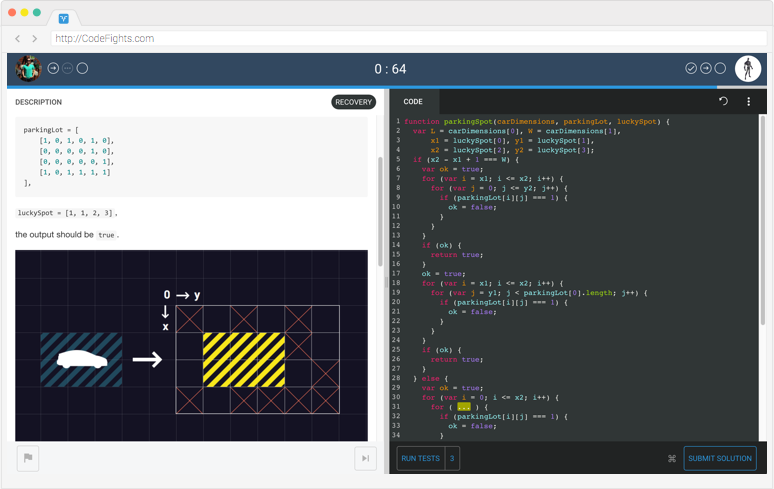While the Chinese IT labor market is still adopting American practice, in the US they hire programmers "effortlessly"

The IT labor market is still a big demand for professionals, and software developers in particular. But there are a lot of applicants too. The search for “the very same” specialist sometimes turns into a search for a needle in a haystack. Recruiters are forced to use different methods of recruitment, but as it turned out, using the same IT technology can not always help with this. And sometimes it even complicates the situation.
There are not so many "good" companies. Therefore, in an attempt to find a job there, applicants are ready to do much: to move to another district, city, and even to another country.
Despite the shake-up and stagnation of the Chinese economy, over the past six years, it has shown an increase of about 6.5%. The greatest treasure in this process makes the Chinese IT industry. Moreover, many startups from this country (including Baidu, Alibaba and Tencent) are widely heard in Silicon Valley. According to the report of the Harvard Business School, valuable personnel provide 11-15% growth in Chinese GDP, and moreover, highly qualified specialists hardly meet the demand existing in the market.
')
This led to a “turnover” of personnel: companies began to entice the most talented employees from each other. They are offered higher salaries compared to their former place of work. Takeoff is often 20-30%.
Housing problem
The migration of capable IT specialists from small cities to larger ones has become a global trend. In China, it has a pronounced character and has been holding for several years. However, expensive living conditions in cities such as Beijing, Shanghai, Shenzhen, are a significant problem on the road to success. This is especially true of young professionals who did not have time to save enough money. The same problem is observed in Silicon Valley.
In Beijing, the monthly rent of a one-room apartment on the outskirts of the city will cost $ 340-750. For similar housing in the center of the price range will change to $ 750-1300. Moreover, the prices for the purchase and rental of housing in this region are growing every year by 16% and 12%, respectively, according to TechCrunch. For the inhabitants of Silicon Valley, these figures do not seem "exorbitant", but in China, not all IT professionals can boast of such high salaries to pull such costs.
At the Beijing office of the Chinese company Baidu, the salary of a young specialist is $ 16-20 thousand per year. If we compare the ratio of numbers with the United States, then at the rental price of $ 3,750-6,500, the salary of an IT specialist is about $ 100,000 per year. So, the Chinese junior only remains how to live on the outskirts of large cities.
If someone tried his luck in the largest cities of China and came back, the next time he would be met with a little less open arms in the cities. IT companies (or their branches) from these cities may be no less advanced, and the cost of living will be lower.
Principle of salary formation
Many large IT companies have their own hierarchy, which determines the place of the employee in the team, and of course, the salary. Sometimes the system of levels in the hierarchy is so complex that applicants cannot figure it out at the first attempt, and change the opinion about the company for the worse. But if a specialist still managed to get a job in a firm, this does not mean that tomorrow he will not leave it.

USA
“Flow” mainly occurs with specialists at T4-T7 levels at Baidu and 62-65 at Microsoft. In accordance with the number of these levels, there is a certain variation in wages, adjusted for market realities. The more often they try to entice certain employees, the higher the payment can be made for the services of workers in this specialization, and the remaining levels are adjusted accordingly. If an IT professional has moved to a Chinese company from an American company (for example, Microsoft, Google or Amazon), then, along with his salary, he is likely to increase the level in the hierarchy. However, in the reverse situation, this principle does not work.
Those IT professionals who are planning to move to China are in for a surprise: there may be no “lifting” money. Increasingly, Chinese firms do without it. They are willing to pay high salaries by local standards, but will have to move at their own expense.
Well, you should still make a reservation that in Chinese companies the level systems are not as rigid as in the US. In addition to the above levels, management considerations are taken into account. True, their influence is not so deterministic and calculated. In this plan, for each employee, everything is decided individually.

China
Unnatural selection
About 8 million Americans do not work anywhere and / or are looking for work. Meanwhile, 6 million vacancies remain open, writes TechCrunch. This situation seems ambiguous against the background of popular belief about the negative impact of technological progress on the labor market.
Most applicants believe that the need to actively use IT technology has made the job search process itself more complex and time consuming. About 85% of vacancies are posted exclusively on the network. Their description and professional requirements are often generated semi-automatically, the formation of a database of candidates is performed by keywords.
As a result, a lot of unsuitable people get on the list of applicants. The task of the recruiter is to filter them out with special filters. However, this is not so easy to do. This becomes a particularly serious problem when the selection of candidates cannot be formalized, or the formalization does not work effectively.
In the case of the search for programmers, not only automation, but also traditional methods of searching employees work poorly. Therefore, recruiters are forced to look for specialists through acquaintances, at conferences, hackathons - in general, they use alternative methods.
Another option for selecting candidates for developers is gamification.
Competitive recruiting
The company CodeFights is creating a gaming platform for developers, with which they can improve their programming skills, solving various problems and competing in speed and efficiency with colleagues in the profession. Founder and CEO of startup Tigran Sloyan says that the team from the very beginning thought about turning CodeFlights into a platform for searching for employees, but wanted to make sure that the idea worked.

The project team conducted several small experiments, and then launched a joint project with the service ordered by Uber trips - CodeFights employees implemented the UberBot bot, which gave users the tasks compiled by the startup taxi team. For any task given a certain amount of time. Users had to solve the problem faster and more efficiently bot.
Among the proposed tasks - finding the optimal route for the car and other problems faced by Uber. It was this partnership that pushed CodeFights management to the decision to introduce recruiting tools into the product.
Now in CodeFights, developers can compete in ingenuity with employees of large technology companies. The application implements bots from such IT organizations as Asana, Dropbox, Go Daddy, Thumbtack, Evernote, and so on.
Fight a bot consists of three rounds. In each round, the player needs to solve one problem. The faster he solves it, the more points he gets. After the user loads the solution, it passes automatic tests on the "cloud" platform - it takes from one to four seconds (depending on the selected programming language). The decision is considered correct only if it has successfully passed all the tests. If the participant wins the battle with the bot, he is redirected to a page where he can fill out an application for work in the company.

Applicants understand the benefits of this method of hiring. One of them is the ability to skip one of the selection stages, saving yourself time. Thus, two lines are formed - unfiltered candidates obtained in the usual search for applicants, and winners of tournaments in CodeFights. In the first case, recruiters will hire 1 out of 30 people, and in the second, 1 out of 5.
CodeFights reports that in September the number of competitions reached 1.5 million. Over the past quarter, the customer base of the service has doubled every month.
Gamification of the hiring process allows you to rely less on such irrelevant indicators as a diploma, place of residence, national, gender stereotypes and biography. It is known that not all colleges and universities are able to prepare a specialist who meets the demand in the labor market.
So, it is fair to evaluate the applicant based on his real skills, regardless of which school and which university he attended. 80% of candidates who successfully passed through CodeFights did not study at elite universities and did not live in such large cities as San Francisco or New York. Therefore, this approach promises to be more efficient, since it cuts off indirect and unreliable search parameters.
Moreover, 30% of candidates in CodeFights are women. This is three times more than the average for Silicon Valley. Thus, a new way of hiring also equalizes men and women. It is no secret that the proportion of men in IT has always been much higher.

“In the 90s, many women who graduated from programming departments chose other activities because their professions were not as in demand as they are today. When digital technologies penetrated all spheres of life, the need for excellent specialists increased many times over. However, stereotypes accepted in society still prevent many girls from trying their hand at IT.
Microsoft successfully fights against such prejudices with the help of training programs, contests and research grants for schoolchildren and young professionals that we conduct as part of the global Youthspark initiative, ” says Anna Kulashova, Director of Microsoft's Department for Small and Medium-sized Organizations and Partners.
Gamification in recruiting will be applied not only in the case of a search for programmers, but gradually spread to other specialties and industries - accounting, finance, and any areas where it is easy to organize qualification tests. CodeFights CEO Tigran Sloyan is confident that the future of recruitment will be like that. If desired, similar technology of hiring can be applied in less formalized areas - for example, in design. The main thing is to build an effective system of operational expertise and formulate clear assessment criteria.
One of the world's largest PR agencies, Ketchum, recruits low-level employees using the LaunchPad app. Candidates can apply for a place in the annual Summer Fellows program - a 10-week paid internship program held in all departments of the company.
Every year, in the company, 15 trainee positions are opened in the company, for which, on average, 2,000 people apply. Instead of having hundreds of interviews and selecting the best candidates, Ketchum invites them to compete in the mobile game. Future employees will have to solve two problems. The system evaluates their creative and communication skills. Unlike the system implemented in CodeFights, in LaunchPad, participants do not perform tasks separately from each other.

If the future of hiring really cannot be imagined without gamification, then the formation of a new type of thinking of recruiters and applicants is inevitable. In this case, do not waste time - you need to start developing this thinking already in universities. If students master this approach and will be guided by it when performing assignments, then they will be ready after graduation to compete for a place under the sun according to the new rules. Then, teachers will be required to rebuild teaching methods accordingly and take on the role of guides to the world of competitive recruiting.
Source: https://habr.com/ru/post/314876/
All Articles